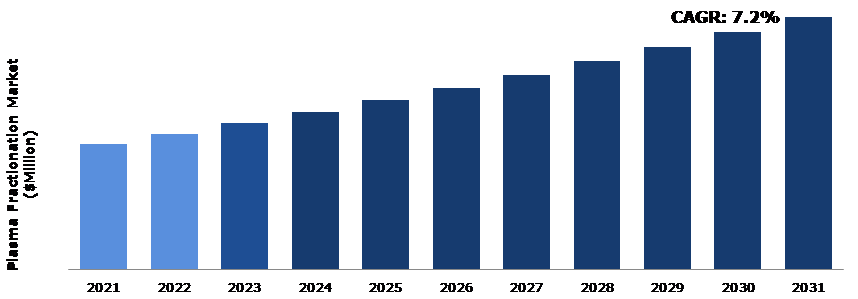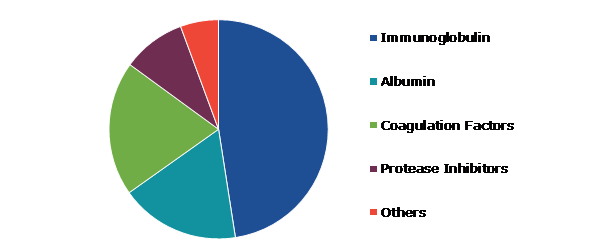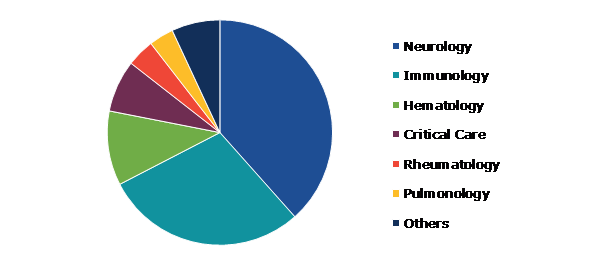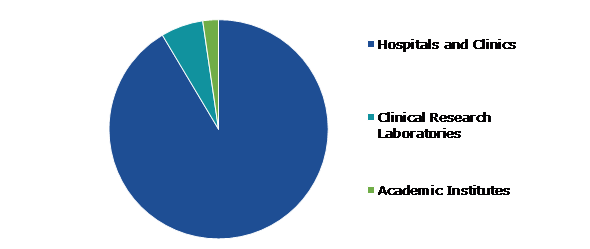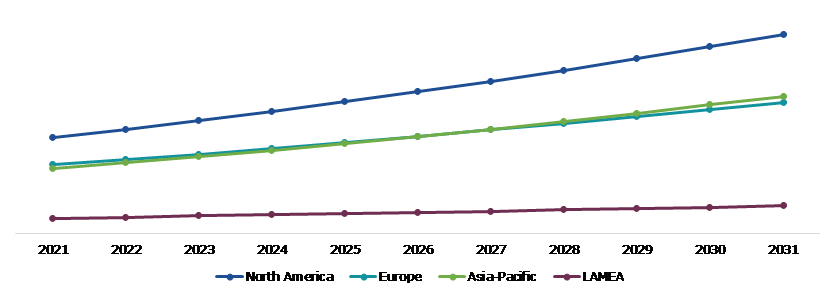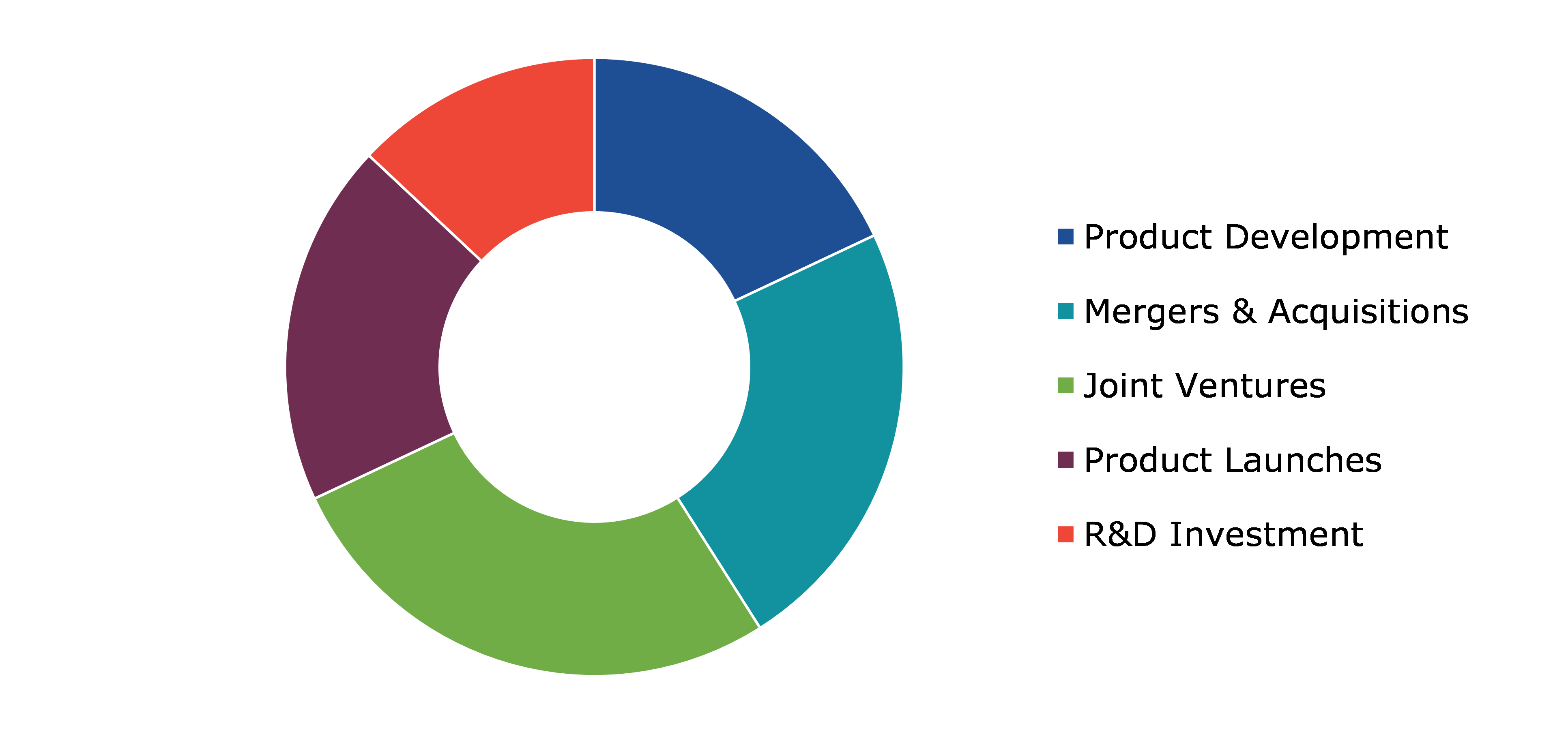Plasma Fractionation Market Report
RA01945
Plasma Fractionation Market by Product (Immunoglobulin, Albumin, Coagulation Factors, Protease Inhibitors, and Others), Application (Neurology, Immunology, Hematology, Critical Care, Rheumatology, Pulmonology, and Others), End User (Hospitals & Clinics, Clinical Research Laboratories, and Academic Institutes) and Regional Analysis (North America, Europe, Asia-Pacific, and LAMEA): Global Opportunity Analysis and Industry Forecast, 2022-2031
Global Plasma Fractionation Market Analysis
The Global Plasma Fractionation Market Size was $28,194.40 million in 2021 and is predicted to grow with a CAGR of 7.2%, by generating a revenue of $56,870.10 million by 2031.
Global Plasma Fractionation Market Synopsis
Modern plasma fractionation combines manufacturing steps to isolate the fractions of blood plasma, in a sequential and integrated manner, the crude fractions that are further purified into individual therapeutic products. Growth in population of elderly people around the globe, who are more susceptible to rare disorders that necessitate the use of blood derivatives, is a major driver of the market's expansion. Furthermore, increase in use of immunoglobulins and alpha-1-antitrypsin in various fields of medicine globally is expected to drive the market growth. Another key factor driving the growth of this market is increase in blood collection facilities around the globe.
However, the potential emergence of new pathogenic agents that can withstand current viral inactivation treatments, as well as the potential effect of given purification technologies on the development of immunogenic properties in proteins, are the current major problems in plasma fractionation. In addition, the high cost of plasma therapy prevents the market from expanding. Furthermore, increase in use of recombinant alternatives for the treatment of autoimmune diseases, such as fibrinogen concentration and protease inhibitor, hampers the growth of the plasma fractionation market.
Furthermore, lifestyle such as consumption of alcohol & tobacco and fast food are increasing the risk of inflammatory disorders in the people, which further increases the opportunities for the plasma fractionation market growth. Moreover, various activities by key market players, such as product launches, partnerships, mergers, and acquisitions, to introduce technologically advanced plasma fractionation techniques and products into the market, are expected to drive the market growth. For instance, in January 2022, Octapharma received approval to expand the indications for cutaquig in the European Union (EU). Cutaquig is a human immunoglobulin that is administered subcutaneously. It gives many patients the acquired immune deficiencies flexible treatment options.
According to regional analysis, the Asia-Pacific plasma fractionation market size is anticipated to show the fastest growth by 2031. The presence of governmental bodies that regulate & supervise plasma collection, fractionation, and sales is a significant factor driving the market growth.
Plasma Fractionation Overview
Plasma is the most important liquid component of blood, containing high concentration of various proteins. Human plasma contains different proteins; however, only a few of these proteins are useful in the production of therapeutic plasma products. It is mostly water, with trace amounts of minerals, salts, ions, nutrients, and proteins in solution.
Plasma fractionation is the classification of the various components of blood plasma, which is a component of blood collected through blood fractionation. After plasma fractionation, wide range of life-saving products such as immunoglobulins, protease inhibitors, anticoagulants, albumins, and coagulation factors are obtained for preventing, managing, and treating various life-threatening human injuries & illnesses.
COVID-19 Impact on Global Plasma Fractionation Market
The COVID-19 pandemic has impacted every industry on the planet. For instance, after the WHO declared COVID-19 a pandemic, countries around the globe implemented nationwide lockdowns to practice social distancing as a preventative measure. This caused disruption, limitation, challenges, and changes in every industry sector. Similarly, the pandemic had an impact on the plasma fractionation industry. For instance, the COVID-19 pandemic has reduced the number of blood donations and plasma collections, stifling market growth. However, decrease in raw material supply was offset by a drop in demand for plasma derivatives when nationwide lockdowns began, as elective surgical procedures were postponed and treatment for other medical conditions was additionally hampered. Furthermore, while overall plasma supply in countries was maintained, some areas faced shortages. As a result, the viral outbreak harmed the plasma fractionation market.
However, due to the disruption in the plasma collection process, the market grew slowly. Despite being referred to as ‘essential infrastructure’, plasma collection has been hampered by increase in the number of COVID-19 cases as well as its guidelines such as social distancing & stay-at-home orders. According to CSL Limited's annual report for the fiscal year 2020/2021, COVID-19 impact on plasma fractionation market reduced plasma collection volume while increasing collection costs in terms of donor compensation.
Increase in use of Immunoglobulin to Drive the Plasma Fractionation Market Growth
Immunoglobulin is an antibody that is found in immune system cells. It is used to treat conditions such as immunodeficiency diseases, idiopathic thrombocytosis purpura (ITP), Kawasaki disease, and nervous system disorders. Immunoglobulins are further used to treat lupus and vasculitis, both of which are rare diseases. Immunoglobulins, such as IVIG, are used to treat blood diseases such as hemophilia for which no other treatment is available.
Moreover, immunoglobulins are commonly prescribed for people with myasthenia gravis, Guillen-Barre syndrome, multiple myeloma, acquired factor VIII inhibitors syndrome, autoimmune neutropenia, post-transfusion purpose, and polymyositis/dermatomyositis. In addition, they can be used to treat primary & secondary immunodeficiencies. As a result, growth in awareness and widespread adoption of immunoglobulins in medicine drive the plasm fractionation market growth.
To know more about global plasma fractionation market drivers, get in touch with our analysts here.
Recombinant Therapies Urgently Needed as an Alternative to Plasma-derived Medicines, Limiting Market Expansion
Many recombinant alternatives for various plasma-driven therapies have been developed in 2020. Recombinase products are used for prophylaxis and are less immunogenic than plasma-derived products, and have significant advantages, such as less frequent administration and greater efficacy in prophylactic use. Growth in use of recombinant factor and its increased use in prophylactic therapies are thus the major factors limiting the adoption of plasma products. In addition, increase in use of recombinant alternatives for the treatment of autoimmune diseases, such as fibrinogen concentration and protease inhibitor, has hampered the growth of the plasma fractionation market. Furthermore, the plasma fractionation market demand is hampered by restrictive medical reimbursement policies.
Government Initiatives and Increase in Investments for R&D Activities to Fuel the Market
Increase in government funding and company investments in plasma therapy R&D activities are expected to increase plasma fractionation market share. The COVID-19 pandemic has created numerous opportunities for biotech & biopharma companies to invest in plasma therapy R&D. Many companies started working together to determine the efficacy of plasma therapy on COVID-19 patients. Grifols, a biopharma company specializing in plasma-derived products, for instance, collaborated with the Food and Drug Administration (FDA) and the Biomedical Advanced Research Development Authority (BARDA) in March 2020 to develop plasma therapeutics for COVID-19.
Furthermore, growth in number of plasma collection centers around the globe is a significant factor in the market's growth. For instance, Bio Products Laboratory Ltd (BPL), a leading manufacturer of plasma-derived protein therapies, will open its 29th plasma donation center in April 2022. Furthermore, Freedom Plasma will open its fourth plasma donation center in Ohio, U.S., in October 2022. As a result, the establishment of new plasma centers around the globe is expected to boost production of plasma-based products, thereby boosting market plasma fractionation market opportunity.
To know more about global plasma fractionation market opportunities, get in touch with our analysts here.
Global Plasma Fractionation Market, by Product
Based on product, the market has been divided into immunoglobulin, albumin, coagulation factors, protease inhibitors, and others. Among these, the immunoglobulin subsegment accounted for the highest market share in 2021 whereas the coagulation subsegment is estimated to show the fastest growth during the forecast period.
Global Plasma Fractionation Market Share, by Product, 2021
Source: Research Dive Analysis
The immunoglobulin subsegment accounted for a highest plasma fractionation market share in 2021 and is anticipated to show the fastest growth by 2031. Rise in geriatric population coupled with an increase in the prevalence of rare diseases, surge in number of plasma collection centers, expansion in use of immunoglobulins in various therapeutic areas, and various initiatives by key market players are predicted to drive the market during the forecast period. Various applications of immunoglobulin in conditions such as primary and secondary immunological deficiencies, autoimmune diseases, and inflammatory diseases are responsible for the growth of this segment. Another element that drives the expansion of the segment is the global uptick in immunology-related research.
The coagulation factors subsegment accounted for a second highest plasma fractionation market share in 2021. The market for coagulation factors is expanding as a result of factors such as new medication approval, high prevalence of bleeding diseases, and growth in initiatives & donations for people with severe bleeding disorders such as hemophilia. For instance, in April 2019, Grifols International SA, a supplier of plasma-derived therapeutics, provided blood clotting factor medications (100 million international units) for the treatment of hemophilic patients as part of a long-term initiative to support people with hemophilia.
Global Plasma Fractionation Market, by Application
Depending on application, the market has been divided into neurology, immunology, hematology, critical care, rheumatology, pulmonology, and others. Among these, the neurology subsegment accounted for the highest revenue share in 2021.
Global Plasma Fractionation Market Size, by Application, 2021
Source: Research Dive Analysis
The neurology subsegment accounted for the highest plasma fractionation market share in 2021. The global increase in prevalence of neurological disorders is a significant driver of the market growth. For instance, the Centers for Disease Control and Prevention estimates that over 795,000 Americans have a stroke each year. Furthermore, growth in elderly population increases the likelihood of neurovascular illnesses such as stroke. In addition, the risk of having a stroke double after the age of 55, which encourages the use of plasma-based products for treatment and promotes market expansion.
Global Plasma Fractionation Market, by End User
Based on end user, the market has been divided into hospitals & clinics, clinical research laboratories, and academic institutes. Among these, the hospitals & clinics subsegment accounted for the highest revenue share in 2021.
Global Plasma Fractionation Market Trends, by End User, 2021
Source: Research Dive Analysis
The hospitals & clinics subsegment accounted for the highest market share in 2021. This is owing to rise in off-label use of plasma fractionation products in hospitals to treat a number of ailments, improved infrastructure, and healthcare services provided by hospitals. Furthermore, there is high demand for plasma fractionation products due to the complicated illnesses that can be addressed in contemporary clinical settings. Moreover, rise in surgical operations and utilization of plasma-derived products both contribute to the market's expansion. According to the NCBI, between January 1, 2019, and January 30, 2021, 13 million surgical procedures were performed in the U.S. These elements are expected to support the market expansion.
Global Plasma Fractionation Market, Regional Insights
The plasma fractionation market is analyzed across North America, Europe, Asia-Pacific, and LAMEA.
Global Plasma Fractionation Market Size & Forecast, by Region, 2021-2031 (USD Million)
Source: Research Dive Analysis
The Market for Plasma Fractionation in North America to be the Most Dominant
The North America plasma fractionation market analysis accounted for the highest market share in 2021. Due to the presence of prominent market players, expansion in plasma fractionation-related R&D activities, and growth in geriatric population, the North America is anticipated to account for a sizeable portion of the global plasma fractionation market. Rise in prevalence of various genetic diseases, growth of geriatric population, and rise in healthcare expenditure are all significant factors driving growth in the region. According to the Alzheimer's Association's March 2021 report, approximately 6.2 million people aged 65 and up in the U.S. have Alzheimer's-related dementia. This figure is expected to rise to 13.8 million by 2060. Thus, the high prevalence of Alzheimer's disease and the efficacy of the plasma fractionation product in treatment drive the regional market growth during the forecast period.
Competitive Scenario in the Global Plasma Fractionation Market
Investment and agreement are common strategies followed by major market players. For instance, in September 2022, the Ministry of Health, Labour and Welfare of Japan granted CSL Behring K.K. manufacturing and marketing approval for Berinert S.C. Injection 2000, a lyophilized human C1-esterase inhibitor concentrate for subcutaneous (SC) injection in plasma derivative, for the prevention of acute hereditary angioedema (HAE) attack.
Source: Research Dive Analysis
Some of the leading plasma fractionation market players are Kedrion S.P.A, Octapharma AG, Japan Blood Products Organization, Biotest AG, CSL Behring, Grifols, S.A., China Biologic Products Holdings, Inc., Takeda Pharmaceutical Company Limited, Bio Products Laboratory Ltd., and LFB Group.
| Aspect | Particulars |
| Historical Market Estimations | 2020 |
| Base Year for Market Estimation | 2021 |
| Forecast Timeline for Market Projection | 2022-2031 |
| Geographical Scope | North America, Europe, Asia-Pacific, LAMEA |
| Segmentation by Product |
|
| Segmentation by Application |
|
| Segmentation by End User |
|
| Key Companies Profiled |
|
Q1. What is the size of the global plasma fractionation market?
A. The size of the global plasma fractionation market was over $28,193.80 million in 2021 and is projected to reach $56,870.10 million by 2031.
Q2. Which are the major companies in the plasma fractionation market?
A. Kedrion S.P.A, Octapharma AG, Japan Blood Products Organization are some of the key players in the global plasma fractionation market.
Q3. Which region, among others, possesses greater investment opportunities in the near future?
A. The Asia-Pacific region possesses great investment opportunities for investors to witness the most promising growth in the future.
Q4. What will be the growth rate of the Asia-Pacific plasma fractionation market?
A. Asia-Pacific plasma fractionation market is anticipated to grow at 7.6% CAGR during the forecast period.
Q5. What are the strategies opted by the leading players in this market?
A. Agreement and investment are the two key strategies opted by the operating companies in this market.
Q6. Which companies are investing more on R&D practices?
A. Kedrion S.P.A, Octapharma AG, Japan Blood Products Organization, Biotest AG, CSL Behring, and Grifols, S.A. are the companies investing more on R&D activities for developing new products and technologies.
1.Research Methodology
1.1.Desk Research
1.2.Real time insights and validation
1.3.Forecast model
1.4.Assumptions and forecast parameters
1.5.Market size estimation
1.5.1.Top-down approach
1.5.2.Bottom-up approach
2.Report Scope
2.1.Market definition
2.2.Key objectives of the study
2.3.Report overview
2.4.Market segmentation
2.5.Overview of the impact of COVID-19 on Global plasma fractionation market
3.Executive Summary
4.Market Overview
4.1.Introduction
4.2.Growth impact forces
4.2.1.Drivers
4.2.2.Restraints
4.2.3.Opportunities
4.3.Market value chain analysis
4.3.1.List of raw material suppliers
4.3.2.List of manufacturers
4.3.3.List of distributors
4.4.Innovation & sustainability matrices
4.4.1.Technology matrix
4.4.2.Regulatory matrix
4.5.Porter’s five forces analysis
4.5.1.Bargaining power of suppliers
4.5.2.Bargaining power of consumers
4.5.3.Threat of substitutes
4.5.4.Threat of new entrants
4.5.5.Competitive rivalry intensity
4.6.PESTLE analysis
4.6.1.Political
4.6.2.Economical
4.6.3.Social
4.6.4.Technological
4.6.5.Environmental
4.7.Impact of COVID-19 on plasma fractionation market
4.7.1.Pre-covid market scenario
4.7.2.Post-covid market scenario
5.Plasma Fractionation market Analysis, by Product
5.1.Overview
5.2.Immunoglobulin
5.2.1.Definition, key trends, growth factors, and opportunities
5.2.2.Market size analysis, by region,2021-2031
5.2.3.Market share analysis, by country,2021-2031
5.3.Albumin
5.3.1.Definition, key trends, growth factors, and opportunities
5.3.2.Market size analysis, by region,2021-2031
5.3.3.Market share analysis, by country,2021-2031
5.4.Coagulation Factors
5.4.1.Definition, key trends, growth factors, and opportunities
5.4.2.Market size analysis, by region,2021-2031
5.4.3.Market share analysis, by country,2021-2031
5.5.Protease Inhibitors
5.5.1.Definition, key trends, growth factors, and opportunities
5.5.2.Market size analysis, by region,2021-2031
5.5.3.Market share analysis, by country,2021-2031
5.6.Others
5.6.1.Definition, key trends, growth factors, and opportunities
5.6.2.Market size analysis, by region,2021-2031
5.6.3.Market share analysis, by country,2021-2031
5.7.Research Dive Exclusive Insights
5.7.1.Market attractiveness
5.7.2.Competition heatmap
6.Plasma Fractionation market Analysis, by Application
6.1.Overview
6.2.Neurology
6.2.1.Definition, key trends, growth factors, and opportunities
6.2.2.Market size analysis, by region,2021-2031
6.2.3.Market share analysis, by country,2021-2031
6.3.Immunology
6.3.1.Definition, key trends, growth factors, and opportunities
6.3.2.Market size analysis, by region,2021-2031
6.3.3.Market share analysis, by country,2021-2031
6.4.Hematology
6.4.1.Definition, key trends, growth factors, and opportunities
6.4.2.Market size analysis, by region,2021-2031
6.4.3.Market share analysis, by country,2021-2031
6.5.Critical care
6.5.1.Definition, key trends, growth factors, and opportunities
6.5.2.Market size analysis, by region,2021-2031
6.5.3.Market share analysis, by country,2021-2031
6.6.Rheumatology
6.6.1.Definition, key trends, growth factors, and opportunities
6.6.2.Market size analysis, by region,2021-2031
6.6.3.Market share analysis, by country,2021-2031
6.7.Pulmonology
6.7.1.Definition, key trends, growth factors, and opportunities
6.7.2.Market size analysis, by region,2021-2031
6.7.3.Market share analysis, by country,2021-2031
6.8.Others
6.8.1.Definition, key trends, growth factors, and opportunities
6.8.2.Market size analysis, by region,2021-2031
6.8.3.Market share analysis, by country,2021-2031
6.9.Research Dive Exclusive Insights
6.9.1.Market attractiveness
6.9.2.Competition heatmap
7.Plasma Fractionation Market Analysis, by End-user
7.1.Hospitals and Clinics
7.1.1.Definition, key trends, growth factors, and opportunities
7.1.2.Market size analysis, by region,2021-2031
7.1.3.Market share analysis, by country,2021-2031
7.2.Clinical Research Laboratories
7.2.1.Definition, key trends, growth factors, and opportunities
7.2.2.Market size analysis, by region,2021-2031
7.2.3.Market share analysis, by country,2021-2031
7.3.Academic Institutes
7.3.1.Definition, key trends, growth factors, and opportunities
7.3.2.Market size analysis, by region,2021-2031
7.3.3.Market share analysis, by country,2021-2031
7.4.Research Dive Exclusive Insights
7.4.1.Market attractiveness
7.4.2.Competition heatmap
8.Plasma Fractionation Market, by region
8.1.North America
8.1.1.U.S.
8.1.1.1.Market size analysis, by Product, 2021-2031
8.1.1.2.Market size analysis, by Application, 2021-2031
8.1.1.3.Market size analysis, by End-user, 2021-2031
8.1.2.Canada
8.1.2.1.Market size analysis, by Product, 2021-2031
8.1.2.2.Market size analysis, by Application, 2021-2031
8.1.2.3.Market size analysis, by End-user, 2021-2031
8.1.3.Mexico
8.1.3.1.Market size analysis, by Product, 2021-2031
8.1.3.2.Market size analysis, by Application, 2021-2031
8.1.3.3.Market size analysis, by End-user, 2021-2031
8.1.4.Research Dive Exclusive Insights
8.1.4.1.Market attractiveness
8.1.4.2.Competition heatmap
8.2.Europe
8.2.1.Germany
8.2.1.1.Market size analysis, by Product, 2021-2031
8.2.1.2.Market size analysis, by Application, 2021-2031
8.2.1.3.Market size analysis, by End-user, 2021-2031
8.2.2.UK
8.2.2.1.Market size analysis, by Product, 2021-2031
8.2.2.2.Market size analysis, by Application, 2021-2031
8.2.2.3.Market size analysis, by End-user, 2021-2031
8.2.3.France
8.2.3.1.Market size analysis, by Product, 2021-2031
8.2.3.2.Market size analysis, by Application, 2021-2031
8.2.3.3.Market size analysis, by End-user, 2021-2031
8.2.4.Spain
8.2.4.1.Market size analysis, by Product, 2021-2031
8.2.4.2.Market size analysis, by Application, 2021-2031
8.2.4.3.Market size analysis, by End-user, 2021-2031
8.2.5.Italy
8.2.5.1.Market size analysis, by Product, 2021-2031
8.2.5.2.Market size analysis, by Application, 2021-2031
8.2.5.3.Market size analysis, by End-user, 2021-2031
8.2.6.Rest of Europe
8.2.6.1.Market size analysis, by Product, 2021-2031
8.2.6.2.Market size analysis, by Application, 2021-2031
8.2.6.3.Market size analysis, by End-user, 2021-2031
8.2.7.Research Dive Exclusive Insights
8.2.7.1.Market attractiveness
8.2.7.2.Competition heatmap
8.3.Asia Pacific
8.3.1.China
8.3.1.1.Market size analysis, by Product, 2021-2031
8.3.1.2.Market size analysis, by Application, 2021-2031
8.3.1.3.Market size analysis, by End-user, 2021-2031
8.3.2.Japan
8.3.2.1.Market size analysis, by Product, 2021-2031
8.3.2.2.Market size analysis, by Application, 2021-2031
8.3.2.3.Market size analysis, by End-user, 2021-2031
8.3.3.India
8.3.3.1.Market size analysis, by Product, 2021-2031
8.3.3.2.Market size analysis, by Application, 2021-2031
8.3.3.3.Market size analysis, by End-user, 2021-2031
8.3.4.Australia
8.3.4.1.Market size analysis, by Product, 2021-2031
8.3.4.2.Market size analysis, by Application, 2021-2031
8.3.4.3.Market size analysis, by End-user, 2021-2031
8.3.5.South Korea
8.3.5.1.Market size analysis, by Product, 2021-2031
8.3.5.2.Market size analysis, by Application, 2021-2031
8.3.5.3.Market size analysis, by End-user, 2021-2031
8.3.6.Rest of Asia Pacific
8.3.6.1.Market size analysis, by product, 2021-2031
8.3.6.2.Market size analysis, by Application, 2021-2031
8.3.6.3.Market size analysis, by End-user, 2021-2031
8.3.7.Research Dive Exclusive Insights
8.3.7.1.Market attractiveness
8.3.7.2.Competition heatmap
8.4.LAMEA
8.4.1.Brazil
8.4.1.1.Market size analysis, by product, 2021-2031
8.4.1.2.Market size analysis, by Application, 2021-2031
8.4.1.3.Market size analysis, by End-user, 2021-2031
8.4.2.Saudi Arabia
8.4.2.1.Market size analysis, by Product, 2021-2031
8.4.2.2.Market size analysis, by Application, 2021-2031
8.4.2.3.Market size analysis, by End-user, 2021-2031
8.4.3.UAE
8.4.3.1.Market size analysis, by Product, 2021-2031
8.4.3.2.Market size analysis, by Application, 2021-2031
8.4.3.3.Market size analysis, by End-user, 2021-2031
8.4.4.South Africa
8.4.4.1.Market size analysis, by Product, 2021-2031
8.4.4.2.Market size analysis, by Application, 2021-2031
8.4.4.3.Market size analysis, by End-user, 2021-2031
8.4.5.Rest of LAMEA
8.4.5.1.Market size analysis, by Product, 2021-2031
8.4.5.2.Market size analysis, by Application, 2021-2031
8.4.5.3.Market size analysis, by End-user, 2021-2031
8.4.6.Research Dive Exclusive Insights
8.4.6.1.Market attractiveness
8.4.6.2.Competition heatmap
9.Competitive Landscape
9.1.Top winning strategies, 2021
9.1.1.By strategy
9.1.2.By year
9.2.Strategic overview
9.3.Market share analysis, 2021
10.Company Profiles
10.1.Kedrion S.P.A
10.1.1.Overview
10.1.2.Business segments
10.1.3.Product portfolio
10.1.4.Financial performance
10.1.5.Recent developments
10.1.6.SWOT analysis
10.2.Octapharma AG
10.2.1.Overview
10.2.2.Business segments
10.2.3.Product portfolio
10.2.4.Financial performance
10.2.5.Recent developments
10.2.6.SWOT analysis
10.3.Japan Blood Products Organization
10.3.1.Overview
10.3.2.Business segments
10.3.3.Product portfolio
10.3.4.Financial performance
10.3.5.Recent developments
10.3.6.SWOT analysis
10.4.Biotest AG
10.4.1.Overview
10.4.2.Business segments
10.4.3.Product portfolio
10.4.4.Financial performance
10.4.5.Recent developments
10.4.6.SWOT analysis
10.5.CSL Behring
10.5.1.Overview
10.5.2.Business segments
10.5.3.Product portfolio
10.5.4.Financial performance
10.5.5.Recent developments
10.5.6.SWOT analysis
10.6.Grifols, S.A.
10.6.1.Overview
10.6.2.Business segments
10.6.3.Product portfolio
10.6.4.Financial performance
10.6.5.Recent developments
10.6.6.SWOT analysis
10.7.China Biologic Products Holdings, Inc.
10.7.1.Overview
10.7.2.Business segments
10.7.3.Product portfolio
10.7.4.Financial performance
10.7.5.Recent developments
10.7.6.SWOT analysis
10.8.Takeda Pharmaceutical Company Limited
10.8.1.Overview
10.8.2.Business segments
10.8.3.Product portfolio
10.8.4.Financial performance
10.8.5.Recent developments
10.8.6.SWOT analysis
10.9.Bio Products Laboratory Ltd.
10.9.1.Overview
10.9.2.Business segments
10.9.3.Product portfolio
10.9.4.Financial performance
10.9.5.Recent developments
10.9.6.SWOT analysis
10.10.LFB Group
10.10.1.Overview
10.10.2.Business segments
10.10.3.Product portfolio
10.10.4.Financial performance
10.10.5.Recent developments
10.10.6.SWOT analysis
Plasma fractionation is a technique used to separate the different components and compounds present in blood plasma. These compounds, primarily plasma proteins, are then used to produce therapeutic products which can be administered to the patient for better targeting of the ailment. Plasma fractionation is done either by changing the chemical properties of the plasma proteins or through mechanical processes like depth filtration, centrifugation, or chromatography.
Forecast Analysis of the Plasma Fractionation Market
In recent years, growing use of immunoglobulin to treat conditions such as immunodeficiency diseases, idiopathic thrombocytosis purpura (ITP), Kawasaki disease, and nervous system disorders is expected to be the primary growth driver of the global plasma fractionation market in the forecast years. Along with this, government initiatives and rising investments in R&D are anticipated to offer numerous investment and growth opportunities to the market in the analysis timeframe. Additionally, the growing risk of inflammatory disorders in people is anticipated to push the market higher in the 2022-2031 period. However, growing use of recombinant therapies as an alternative to plasma-driven medicines may restrain the growth of the plasma fractionation market in the forecast period.
Regionally, the plasma fractionation market in the North America region is expected to be the most dominant one by 2031. The rise in the prevalence of various genetic diseases and the growth of geriatric population are projected to be the two main factors behind the growth of the market in this region.
According to the report published by Research Dive, the plasma fractionation market is expected to gather a revenue of $56,870.10 million by 2031 and grow at 7.2% CAGR in the 2022–2031 timeframe. Some prominent market players include Kedrion S.P.A, CSL Behring, Takeda Pharmaceutical Company Limited, Octapharma AG, Grifols, S.A., Bio Products Laboratory Ltd., Biotest AG, China Biologic Products Holdings, Inc., LFB Group, and Japan Blood Products Organization, and many others.
Covid-19 Impact on the Plasma Fractionation Market
The outbreak of the Covid-19 pandemic has had a massive negative effect on almost all industries and businesses across the world. The plasma fractionation market, too, faced a similar fate. The overall demand for plasma fractionation decreased in the pandemic due to reduction in the number of blood donations and plasma collections. Moreover, many elective surgeries were postponed during the pandemic which further reduced the demand for plasma fractionation. All these factors brought down the growth rate of the market.
Key Developments of the Plasma Fractionation Market
The significant companies operating in the industry are adopting numerous growth strategies & business tactics such as partnerships, collaborations, mergers & acquisitions, and launches to maintain a robust position in the overall market, thus helping the plasma fractionation market to flourish. For instance:
- In July 2020, Grifols, a global pharmaceuticals company, announced the acquisition of a Green Cross plasma fractionation facility in Montreal from GC Pharma (Group), another leading pharmaceutical company. This acquisition is expected to help Grifols to scale up their operations globally in the near future.
- In March 2023, Takeda, a pharmaceutical firm, announced its investment of 100 billion Japanese Yen in a new plasma fractionation facility in Osaka, Japan. This is Takeda’s largest investment in plasma-derived therapies and is expected to help the company to cater to the demands of the medical sector comprehensively.
Personalize this research
- Triangulate with your own data
- Request your format and definition
- Get a deeper dive on a specific application, geography, customer or competitor
- + 1-888-961-4454 Toll - Free
- support@researchdive.com

